BLOG & INFO
Nias Literature
A lot of what is known about Nias culture and history come from writings by explorers, colonial administrators, missionaries and researchers. The first written account of Nias was made by Sulayman, a Persian merchant who visited Nias Island in 851 AD. In 1154 AD the Arabic scholar Al-Idrisi published a geographic book for explorers where Nias was described. The next written accounts of importance were made by the British during their time on Nias.
The majority of writings in Nias were made by Dutch colonials and German missionaries during the 19th and 20th centuries. They wrote many books, articles and letters which are used as an important source of reference to this day. A lot of what is known about Nias religions, kinship system and daily life comes from these sources. One of the most important accounts from this period comes from Schröder who worked as a colonial administrator on the Island.
The ‘modern’ period of research started a few decades after Indonesian independence when many anthropologists came to Nias to research the unique culture and architecture of Nias. There are many books and academic articles available for anyone interested in Nias Island written in the last decades.
Johannes Maria Hämmerle and Na’atalui Duha from the Nias Heritage Museum have written several books about various aspects of Nias history and culture. To learn more about this visit our publications page.
For a full list of Nias writings and research visit the Nias Archives Bibliography compiled by Prof. Alain Viaro.
Below is a list of some of the most interesting and important books about Nias that have been published to date:
Books in Indonesian:
Tanah Para Pendekar by Vanni Puccioni

Land of the Warrior: a book about the famous expedition to Nias by explorer Elio Modigliani. During his travel he met head-hunters, warrior chiefs and slave traders, but returned unharmed with a treasure trove of knowledge and artefacts. Modigliani also had a secret mission: to bring back human skulls to confirm the racist theories of Cesare Lombroso. The expedition became a journey of the spirit and of survival. More than a century later the author retraced Modigliani's tracks, searching among the descendants of the warriors for the key to the mystery of his survival.
Jakarta: Gramedia 2016. ISBN 97886020331645
An English e-book version is available on Amazon and iTunes.
For more books in Indonesian and Nias language, please visit our Publications page, where books published by the Nias Heritage Foundation can be found.
Books in English:
Society and Exchange in Nias by Andrew Beatty.

This is one of the most important books published about Nias culture and is often referenced in academic work. The island of Nias in Indonesia is renowned for its "feasts of merit". In pursuit of prestige and a noble title, a Nias chief must slaughter scores of pigs and give away a lifetime's wealth. Based on two years of field research, this book gives an account of kinship and ceremonial exchange in a village of the interior. The first part introduces a unique form of marriage alliance which represents, arguably, a link between elementary and complex social systems and has important implications for kinship theory. The second part contains an account of the feast of merit, a widely-occurring South-East Asian institution.
Oxford: Clarendon 1992. ISBN 0198278659
After the Ancestors: An Anthropologists story by Andrew Beatty.

This book is a personal account and a follow-up to the book Society and Exchange in Nias by the same author. Set on the isolated island of Nias, this is the gripping true story of an anthropologists experience of living in a tribal society during a period of crisis. Featuring a cast of unforgettable characters, it follows a bitter feud between rivals as it escalates into murder, intrigue and revenge. A vivid account of life within a radically different world, it also portrays a unique culture undergoing the transition from tribalism to modernity. A century of alien rule has left the island, once famous for its warrior ethos, with a hybrid culture. As the possibilities for heroic action recede, men raised to be orators and over-reachers rather than church elders and peasants find themselves occupying a stage too small for their personalities.
Cambridge : University Press 2015. ISBN 9781107094789
The religious system and culture of Nias, Indonesia by Peter Suzuki.
As one of the first ‘post-colonial’ books about Nias culture, it is often referenced to this day. Later researchers have sometimes come to different conclusions. Ph.D. thesis, University of Leiden
The Hague: Excelsior 1959.
Traditional Architecture of Nias Island by Alain M. Viaro and Arlette Ziegler
 Viaro and A. Ziegler travelled extensively on Nias Island from 1977 to 1993. Their field work took them all over the island, sometimes walking on foot for days to reach remote villages. Their extensive research, notes, drawings and photos have resulted in many scientific articles and book chapters in several languages. This book is one of the most important on the topic of the vernacular architecture of Nias Island and its different styles.
Viaro and A. Ziegler travelled extensively on Nias Island from 1977 to 1993. Their field work took them all over the island, sometimes walking on foot for days to reach remote villages. Their extensive research, notes, drawings and photos have resulted in many scientific articles and book chapters in several languages. This book is one of the most important on the topic of the vernacular architecture of Nias Island and its different styles.
Gunungsitoli: Nias Heritage Foundation 2006. ISBN 9799574951
Among the Warriors of Nias by Vanni Puccioni

The true story of an expedition, halfway between adventure and anthropology. In 1886 Italian anthropologist Elio Modigliani landed on Nias island, home of headhunters who had fought off Dutch colonizers and military expeditions. Yet, Modigliani explored the island’s wildest regions, witnessing tribal wars, slavery and epidemics. He developed a deep empathy for Nias people and came back to tell the story as well as bringing a fabulous collection of ethnographic specimens for Italian museums. Why did the headhunters spare his life? More than a century later, Vanni Puccioni followed Modigliani’s tracks seeking out the descendants of Nias warriors to get their side of the story, hoping to find the key to his survival.
Florence: Spider & Fish 2017. This is an e-book available for download on Amazon and Itunes
*Also available in Indonesian from Gramedia bookshops under the title "Tanah Para Pendekar".
Traditional Architecture and art on Nias, Indonesia by Petra Gruber and Ulrike Herbig with contributions from A. Viaro & A. Ziegler and others.
 On the occasion of the Conference on Traditional Architecture and Art on Nias at the Museum of Ethnology in Vienna (2006) the contributions of the participating experts were compiled in this book delivering an interdisciplinary view of the unique culture that has emerged on the small island of Nias.
On the occasion of the Conference on Traditional Architecture and Art on Nias at the Museum of Ethnology in Vienna (2006) the contributions of the participating experts were compiled in this book delivering an interdisciplinary view of the unique culture that has emerged on the small island of Nias.
Vienna: IVA ICRA Vienna 2009. ISBN 9793900265120
Nias Tribal Treasures: Cosmic reflections in stone, wood and gold by J.A Feldman et.al.
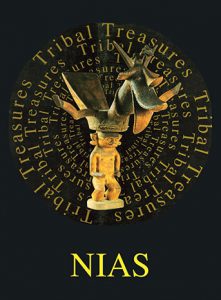
Richly illustrated reference work on the tribal art of Nias from the collection of the Volkenkundig Museum Nusantara. The book includes essays by several Nias researchers: J. Feldman: Nias and its traditional sculptures. A. Viaro: The traditional architecture in the south of Nias. A. Ziegler: Festive areas. Territories and Feasts in the south of Nias. M. de Moor: The importance of Gold Jewellery in Nias culture. H. Maier: Stories from Nias.
Delft: Volkenkundig Museum Nusantara 1990. ISBN 9071423050
Nias Sculpture: Mandala Collection by Achim Sibeth & Bruce W. Carpenter

Nias has achieved legendary status among collectors and scholars of tribal art. This coffetable book is the latest book on the sculptures and art of Nias Island, featuring a broad array of unpublished masterpieces from the collection of the Mandala Foundation. It is a stimulating visual journey to the heart and soul of an ancient people.
Jakarta: Red & White Publishing 2013. ISBN 9789791008723
 The architecture of Nias, Indonesia with special reference to Bawömataluo village by Jerome Allen Feldman
The architecture of Nias, Indonesia with special reference to Bawömataluo village by Jerome Allen Feldman
PhD Thesis about the vernacular architecture of South Nias, particularly the village of Bawömataluo.
New York: Faculty of Philosophy, Columbia University 1977
Cross and Adu: a Socio-historical study on the encounter between Christianity and the Indigenous culture on Nias and the Batu Islands, Indonesia (1865-1965) by Hummel Uwe & Tuhoni Telaumbanua

This study look at the encounter between Christianity and the culture of the indigenous people of Nias. The course of Christianisation transformed the Nias culture. In its turn, the Nias culture shaped a unique form of Christianity in Indonesia. Doctoral thesis Utrecht University.
Zoetermeer: Boekencentrum 2007
Books in German:
Nias, eine eigene Welt: Sagen, Mythen, Überlieferungen by Johannes Maria Hämmerle

Nias - a separate world; legends, myths and traditions. This book by the founder of the Nias Heritage Foundation provides a reinterpretation of old myths from North and Central Nias as described in earlier books. The emphasis of the book is on the interpretation of 13 myths on the origins of Nias people that the author himself has recorded and translated. The information was gathered over many years through interviews with some of the few surviving Nias traditional storytellers.
Sankt Augustin: Academia Verlag 1999. ISBN 3896651471
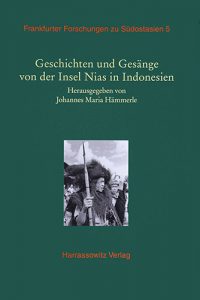 Geschichten und Gesänge von der Insel Nias in Indonesien by Johannes Maria Hämmerle
Geschichten und Gesänge von der Insel Nias in Indonesien by Johannes Maria Hämmerle
Stories and songs from the island of Nias in Indonesia. Research about tales and songs as told in in Nias language written by the founder of the Nias Heritge Foundation. Nias language and culture are affected by outside influences, both linguistic and cultural. For this reason the recording of stories as told in the original language is important.
Wiesbaden: Harrassowitz Verlag 2008. ISBN 9783058124
 Eine Reise Nach Nias by Joachim Freiherr & Von Brenner-Felsach
Eine Reise Nach Nias by Joachim Freiherr & Von Brenner-Felsach
A Journey to Nias. Previously unpublished manuscripts and illustrations from a 1887 expedition to Nias kept at the ethnographic museum of Vienna, edited by Reinhold Mittersakschmöller
Wien: Böhlau Verlag 1998. ISNB 3205989597
 Der Berg des Herrn der Erde: Alte Ordnung und Kulturkonflikt in einem indonesichen Dorf by Wolfgang Marshall
Der Berg des Herrn der Erde: Alte Ordnung und Kulturkonflikt in einem indonesichen Dorf by Wolfgang Marshall
The mountain of the Lord of the earth: Old order and cultural conflict in an Indonesian village. Tells the story about life in the village of Hilizolagötanö in South Nias.
München: Deutcher Taschenbuch Verlag 1976. ISBN 342304181
 Gomo und das traditionelle Haus auf Nias: Baukultur in Indonesien by Johannes M. Hämmerle & Erich Lehner with contributions from Alain Viaro & Arlette Ziegler
Gomo und das traditionelle Haus auf Nias: Baukultur in Indonesien by Johannes M. Hämmerle & Erich Lehner with contributions from Alain Viaro & Arlette Ziegler
Gomo and the traditional houses of Nias : building culture in Indonesia. Overview of the unique architecture and building techniques on Nias Island.
Wien: IVA-ICRA Verlag 2010. ISNB 9783900265229
 Insel Nias: Ansichtskarten by Traian Popescu.
Insel Nias: Ansichtskarten by Traian Popescu.
Nias Island postcards. A collection of postcards, photos and curio from Nias Island including a comprehensive list of museums and private Nias collections around the world. This book also contains a very detailed bibliography of Nias related publications. For further information contact the author on e-mail: traian.popescu@gmx.de
München: Eigenverlag Traian Popescu 2007.
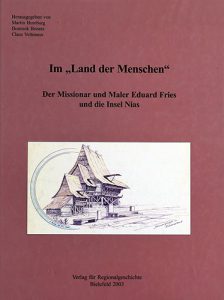 Im 'Land der Menchen', Der Missionar und Maler Eduard Fries und die Insel Nias by Martin Humburg, Dominik Bonatz and Claus Veltman.
Im 'Land der Menchen', Der Missionar und Maler Eduard Fries und die Insel Nias by Martin Humburg, Dominik Bonatz and Claus Veltman.
In the "Land of the humans", the German missionary and painter Eduard Fries writings about his experiences in Nias between 1903 to 1914.
Bielefeld: Verlag fur Regionalgeschichte 2003. ISBN 3895344931
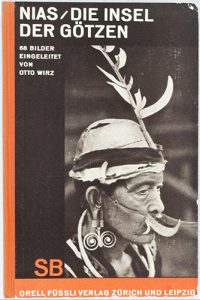 Nias: Die Insel Der Götzen by Otto Wirz
Nias: Die Insel Der Götzen by Otto Wirz
Nias: the Island of the Idols. This book contains many beautiful photographs of Nias people in traditional dress.
Zürich/Leipzig: Orell Füssli 1929
Die Heilkunde der Niasser by Johannes Pieter Kleiweg de Zwaan

The Healing of the Niha. Dutch anthropologist J.P. Kleiweg de Zwaan travelled to Nias in 1910 to do extensive anthropological research. The residents of Nias were known for their martial spirit 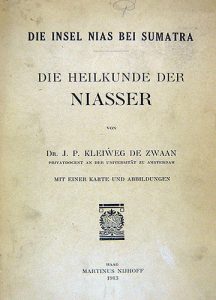 and their unique culture which greatly differed from that of Sumatra. Zwaans conducted studies of the Nias people, and made many plaster casts of them (Rijksmuseum collection).
and their unique culture which greatly differed from that of Sumatra. Zwaans conducted studies of the Nias people, and made many plaster casts of them (Rijksmuseum collection).
Haag: M. Nijhoff 1913
Books in Dutch:
Nias -, vol 1 & 2 by Schröder E.E.W.Gs.

Willem Schröder was a Dutch colonial administrator who served on Nias from 1904 to 1909. Although he did not have a background in ethnography, Schröder became very interested in the culture of Nias Island. After conducting a lot of research he wrote a detailed study about Nias Island titled 'Nias : Ethnographical, geographical and historical notes and studies'. The book consists of two  volumes. The first contains writings about Nias, and the second volume contains photographs and maps. The work of Schröder is a very detailed description of the island and its culture at the time.
volumes. The first contains writings about Nias, and the second volume contains photographs and maps. The work of Schröder is a very detailed description of the island and its culture at the time.
This text and the photographs are still one of the most important references available for researchers who study Nias.
Leiden: Brill 1917
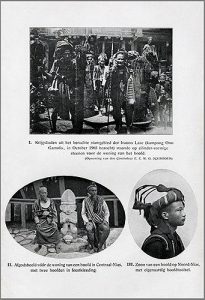 Het eiland Nias en zijne bewoners by Rappard, Th. C.
Het eiland Nias en zijne bewoners by Rappard, Th. C.
Nias Island and its inhabitants. This presentation of the ethnography Nias Island is the result of a journey the author made around south Nias on board the Dutch government steamboat “Condor” in 1905.
S’Gravenhage: Martinus Nijhoff, 1909
Books in French:
Urbanisme et architecture traditionnels du sud de l’île de Nias by Alain Viaro
Urbanism and traditional architecture of southern Nias Island. This was a first study following surveys made by A- Viaro and A. Ziegler in 1977-79. Most of its content is still valid and South Nias architecture is still very much alive. This text is available as a Download.
Paris: UNESCO 180
Symbolic et motifs du Sud de Nias by Jean Paul Barbier.
Symbolic motifs of South Nias. The author Jean Paul Barbier-Mueller spent over half a century assembling an exceptional collection of so called Tribal art and is considered to be one of the world’s foremost experts in this area. He has edited several other books about Southeast Asian art with chapters on Nias, such as Islands and Ancestors: Indigenous styles of Southeast Asia and Statues et sculptures de l'Indonésie primitive dans les collections du musée Barbier-Mueller
Geneve: Collection Barbier – Müller 1978
Books in Italian:
Un Viaggio a Nias by Elio Modigliani

A journey to Nias: this is the classic account by Italian explorer Elio Modigliani of his travels to South Nias in 1886. At the time this was forbidden territory for all foreigners, as the Dutch military had failed to impose colonial rule in this region populated by fierce head hunters. The villages were at war with each other at the time of his visit, and he personally clashed with high-ranking members of Nias society. Yet, Elio Modigliani managed to save his own head and that of his men, and bring back a formidable collection of Nias artefacts for the Ethnographic Museum of Florence, where they are still on display.
Milano: Frateli Freves 1890.
Tra I Tagliatore di Teste by Vanni Puccioni

Among the Headhunters: a book about the famous expedition to Nias by explorer Elio Modigliani. During his travel he met head-hunters, warrior chiefs and slave traders, but returned unharmed with a treasure trove of knowledge and artefacts. Modigliani also had a secret mission: to bring back human skulls to confirm the racist theories of Cesare Lombroso. The expedition became a journey of the spirit and of survival. More than a century later the author retraced his tracks, searching among the descendants of the warriors the key to the mystery of his survival. This book is available in Indonesian (see top of this page)
Venice: Marsilio 2013. ISBN 9788831717106
*Also available in English (Among the Warriors of Nias) and Indonesian (Tanah Para Pendekar).
 L’isola degli antenati di pietra by Scarduelli Pietro
L’isola degli antenati di pietra by Scarduelli Pietro
The Island of the stone ancestors. Social structures and symbols on Nias Island, Indonesia.
Laterza: Biblioteca de cultura moderna 1986
Nias Scholars

Schröder E.E. Willem was a Dutch colonial administrator who served on Nias from 1904 to 1909. His book about Nias is still one of the most important references available for researchers who study Nias.

P. Johannes Hämmerle was born in Germany and came to Nias as a Catholic missionary in 1971. In 1993 he founded the Nias Heritage Foundation. He has written several books about Nias in German, Indonesian and Nias language.

Andrew Beatty is an English anthropologist who spent two years in a remote traditional Nias village in the late 80’s. His book is one of the most important books published about Nias culture and is often referenced in academic work.

Alain Viaro and Arlette Ziegler are Swiss researchers specializing in vernacular architecture and traditional cultures. They travelled extensively on Nias Island from 1977 to 1993. Their extensive research has resulted in many scientific articles and book chapters in several languages.
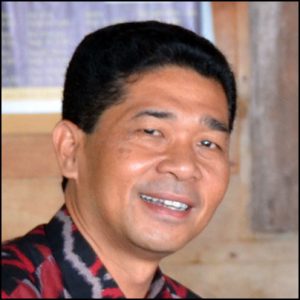
Nata'alui Duha was born in Hilimondregeraya village in south Nias. He started working with the museum in 1991. In 2013 he became the Director of the Museum. He is the author of the book Omo Niha and have edited several other books published by the museum.

Vanni Puccioni. Architect from Italia. After the 2005 earthquake he worked for four years on Nias. There he heard about the adventures of Italian Elio Modigliani and wrote a book about him which is available in Indonesian, Italian and English.
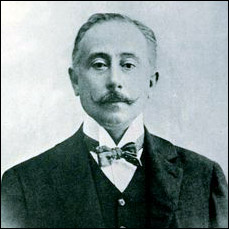
Elio Modigliani was an Italian anthropologist and explorer who made a journey to the south of Nias in 1886. He wrote a famous book about his adventures in Italian.

Peter Suzuki was one of the first researchers to study Nias culture after Independence. His book is often referenced to this day.
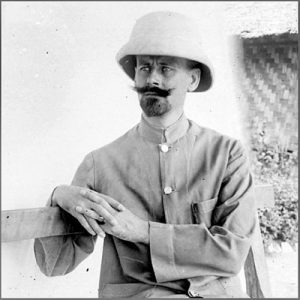
Johannes Pieter Kleiweg de Zwaan was a Dutch anthropologist who travelled to Nias in 1910 to do extensive anthropological research about the origins of Nias people. During his research he made many plaster casts of local peoples faces.

Jerome Feldman is an American Professor of Art History. Since completing his PhD Thesis in 1977 about the architecture of South Nias he has published many academic articles about Nias culture.

